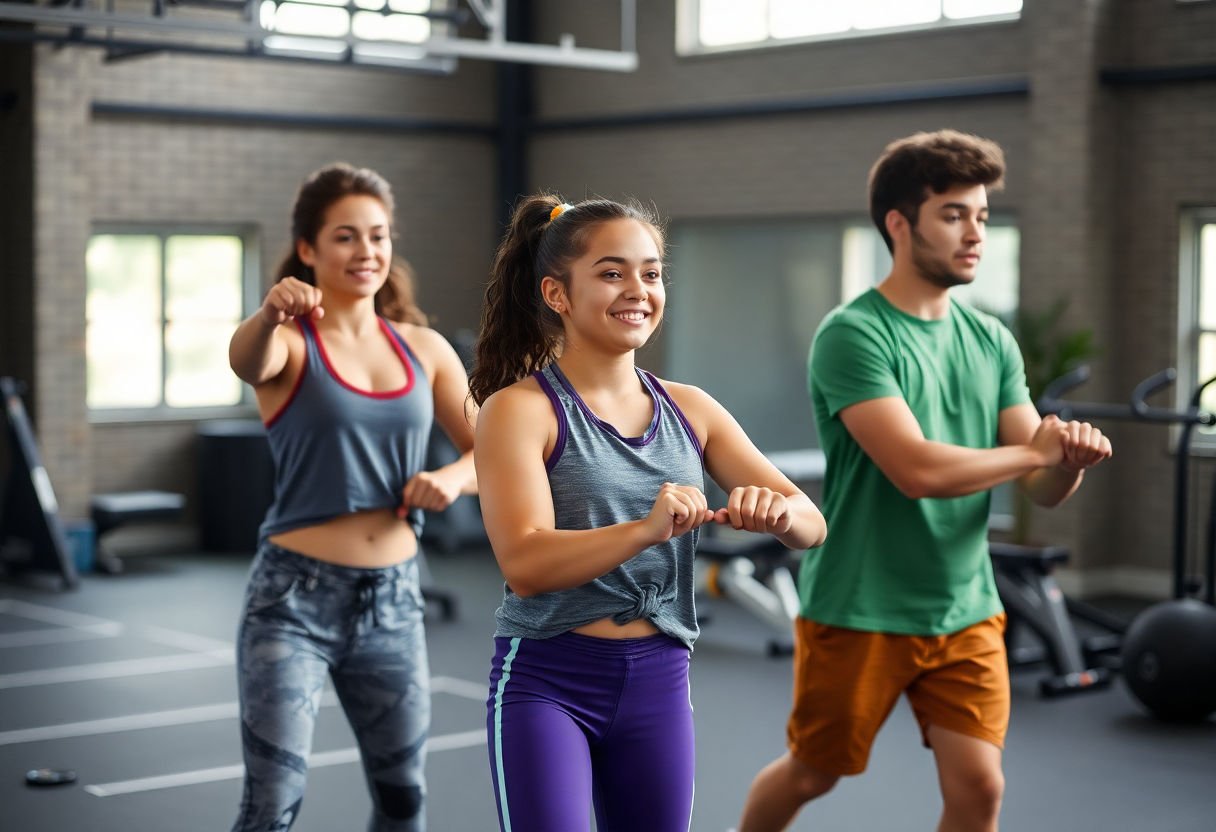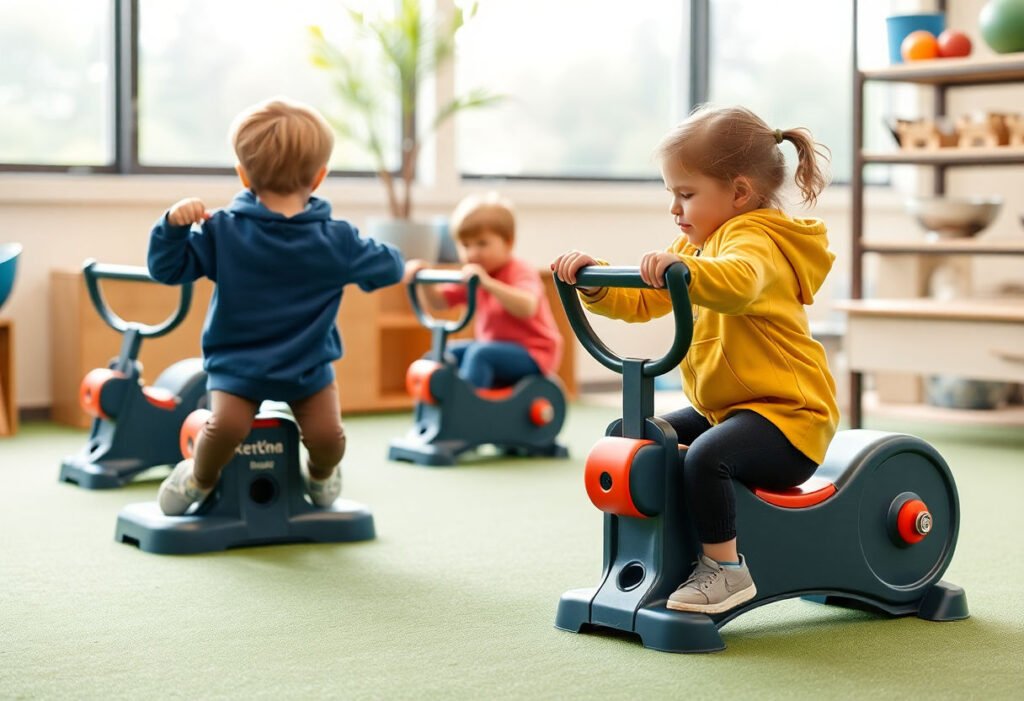Exercise is a fundamental component of a child’s development, contributing significantly to their physical, mental, and social well-being. Selecting the right age-appropriate exercise equipment can play a pivotal role in establishing healthy habits from an early age. This guide will delve into the benefits of regular physical activity for kids and provide insights on how to choose equipment that caters to various stages of development while ensuring safety. From toddlers to teenagers, exploring both popular and budget-friendly options, this article aims to empower parents with the knowledge to foster an enduring love for exercise in their children.
Key Takeaways
- Selecting the right exercise equipment for kids fosters lifelong healthy habits and supports their developmental needs.
- Regular exercise provides children with significant physical, mental, and social benefits, enhancing overall well-being.
- Choosing age-appropriate equipment is crucial to ensure safety and effectiveness in encouraging physical activity among children.
- There are affordable exercise options available that allow parents to equip their kids without incurring excessive costs.
- By integrating exercise into daily routines, parents can help inculcate a lasting appreciation and enthusiasm for physical fitness in their children.
Benefits of Exercise for Kids
Engaging children in regular exercise offers numerous benefits that extend beyond mere physical health. Physically, it enhances cardiovascular fitness, strengthens muscles and bones, and helps maintain a healthy weight. Children who exercise regularly are less prone to obesity-related conditions such as diabetes and heart disease.
Mentally, exercise is a powerful tool for boosting self-esteem, improving mood, and reducing symptoms of anxiety and depression. Physical activity has been shown to enhance cognitive function, potentially leading to better academic performance. It also fosters discipline and concentration, skills that are invaluable both in and out of the classroom.
Socially, participating in exercise—especially in group settings—encourages teamwork, cooperation, and communication. Children learn to work towards common goals, respect others, and develop crucial leadership skills. Activities such as playing team sports can also instill a strong sense of belonging and community, vital for social development.
Exercise provides a creative outlet for energy and stress, helping children manage emotional challenges and frustrations effectively. By establishing a routine of regular physical activity, children are more likely to carry these healthy habits into adulthood. This lifestyle can lead to a higher quality of life and longevity, underscoring the importance of encouraging exercise from a young age.
Understanding and acknowledging these benefits can guide parents in choosing the most suitable exercise equipment for their children, ensuring they support their physiological, psychological, and social development through fun and engaging activities.
Understanding Age-Appropriate Equipment
When selecting exercise equipment for children, it’s crucial to consider their developmental stage to ensure safety and effectiveness. For toddlers, equipment should be simple, colorful, and designed to enhance basic motor skills. Items such as soft mats, balance beams, and small slides can stimulate movement and exploration, fostering critical motor development.
Preschoolers benefit from equipment that encourages imaginative play while building coordination. Consider portable goal nets for soccer or basketball hoops with adjustable heights. Such tools not only promote physical activity but also allow children to engage in group play, enhancing social skills.
School-aged children require equipment that challenges their growing bodies and keeps them engaged. Bikes, jump ropes, and age-appropriate trampolines are excellent choices. These options help improve cardiovascular health and balance, supporting overall physical development and endurance.
Finally, for teenagers, equipment should align with their interests and promote a more comprehensive fitness routine. Consider introducing resistance bands, dumbbells, or yoga mats. These tools support strength training and flexibility, critical components of a well-rounded fitness regimen.
By understanding and selecting age-appropriate exercise equipment, parents can better support their children’s health and developmental needs. It ensures that the equipment is not only safe but also encourages lifelong fitness habits by making exercise engaging and fun.
Safety Considerations

When selecting exercise equipment for children, prioritizing safety is paramount. Ensuring equipment is age-appropriate is the first step in safeguarding your child. Equipment designed for adults or older children can present significant risks when used by younger kids. Always adhere to manufacturer age recommendations to minimize potential hazards.
Supervision is critical when children are using exercise equipment. An adult should always be present to guide children on proper usage and prevent mishaps. Consider setting up the equipment in a safe area, free from obstacles and potential sources of injury.
Routine maintenance checks are essential to ensure the continued safety of exercise equipment. Regularly inspect for any signs of wear and tear, such as loose bolts or frayed ropes, which could compromise the equipment’s integrity. Keeping the equipment in good condition helps prevent accidents and extends its lifespan.
It is also crucial to teach children the correct use of the equipment. Take the time to demonstrate and practice each exercise with them, emphasizing the importance of following instructions. Ensure they understand the risks associated with improper use and the significance of respecting their own limits.
Create a safe exercise environment by selecting equipment with safety features, such as cushioned support, stable bases, and smooth edges. Furthermore, ensure that the floor surface is appropriate, using non-slip mats if necessary to prevent falls and injuries.
By incorporating these safety considerations into the decision-making process, parents can provide a secure environment that allows children to enjoy the myriad benefits of physical activity.
Top Exercise Equipment for Toddlers

For toddlers, engaging with movement-based activities and equipment is crucial for their development, fostering motor skills, coordination, and balance. Choosing the right exercise equipment ensures that these young children have fun while benefiting physically and developmentally. Below are some highly recommended exercise tools for toddlers:
-
Balance Bikes: These bikes are an excellent way for toddlers to develop balance and coordination. Unlike traditional bicycles, balance bikes have no pedals, allowing children to focus entirely on balancing. This foundational skill is essential as they transition to regular bikes as they grow older.
-
Jumping Mats: Also known as toddler trampolines, these provide a safe way for toddlers to enjoy jumping exercises. Jumping mats help build leg strength, enhance coordination, and provide a good cardiovascular workout. Ensure that these mats come with safety handles for additional support.
-
Foam Climbing Blocks: Made of soft materials, foam blocks allow toddlers to climb, stack, and navigate different shapes safely. These actions improve gross motor skills and spatial awareness, encouraging safe exploration and active play.
-
Mini Obstacle Courses: Designing a simple indoor obstacle course with items like tunnels, small hurdles, and crawling paths encourages toddlers to engage in diverse movements, enhancing their agility and problem-solving skills.
These equipment types are particularly effective because they combine play with exercise, ensuring toddlers are both entertained and physically active. It is important to select products designed specifically for the toddler age group to ensure safety and effectiveness, thus laying the groundwork for a healthy, active lifestyle.
Ideal Equipment for School-Aged Children
School-aged children, ranging from approximately six to twelve years old, are at a pivotal stage in their development where exercise not only enhances physical health but also supports cognitive and social skills. Choosing the right equipment for this age group can significantly bolster their enthusiasm for physical activity.
Jump Ropes: A classic choice, jump ropes help improve coordination, balance, and cardiovascular fitness. They are portable, affordable, and can be used both indoors and outdoors, making them perfect for versatile play.
Bicycles: Encouraging cycling not only enhances endurance and leg strength but also fosters a sense of independence and exploration. Ensure the bicycle is appropriately sized to maintain safety and comfort.
Hula Hoops: These vibrant, engaging tools are excellent for enhancing flexibility and dexterity. They also provide a fun, rhythmic activity that children can enjoy alone or with friends, promoting social interaction.
Sports Equipment: Introducing children to sports equipment such as soccer balls, basketballs, or tennis rackets can enhance teamwork skills and instill a love for various sports. Participation in sports also aids in developing discipline and strategic thinking.
Fitness Trackers: While more of a modern option, fitness trackers can add an element of motivation through gamification. These devices help children set and achieve fitness goals, track progress, and celebrate success, which can cultivate a lifelong interest in physical well-being.
Choosing the right equipment for school-aged children should focus on balancing fun with developmental benefits, encouraging a positive attitude towards fitness.
Engaging Teenagers with Exercise Gear

Engaging teenagers in fitness activities requires a strategic approach, particularly as their interests and motivations differ greatly from younger children. To captivate this age group, selecting the right exercise gear can make a significant difference.
First, technology integration in exercise equipment can be crucial. Teenagers are particularly drawn to gadgets that include elements like Bluetooth connectivity, interactive gaming, and online leaderboards. Devices such as smart treadmills, stationary bikes with virtual reality integration, or fitness apps that sync with wearable trackers can transform a routine workout into an engaging experience.
Moreover, versatility and adaptability in equipment is key. Teens benefit from gear that supports a broad range of workouts. Consider weight sets with adjustable settings or resistance bands that offer multiple intensity levels. Such equipment not only caters to their growing physical capabilities but also keeps them challenged and motivated.
Incorporating social elements can also enhance engagement. Encouraging group activities or challenges through shared gear can leverage teens’ social nature. Equipment that facilitates team sports—like basketball hoops or soccer goals—encourages active interaction and peer motivation.
Additionally, offering options that align with current fitness trends can spark interest. Yoga mats, skipping ropes, or balance trainers that resonate with popular workout trends among teens can encourage regular use.
Finally, it’s essential to emphasize individual preferences. Allow teenagers to have a say in selecting their exercise gear. Personal choice fosters ownership and increases the likelihood of sustained interest.
By focusing on these areas, parents can play a pivotal role in nurturing a teenager’s enthusiasm for physical activity, thereby supporting lifelong health and wellness.
Budget-Friendly Options
When it comes to choosing exercise equipment for kids, keeping costs manageable is essential for many families. Fortunately, there are numerous budget-friendly options that allow children to engage in physical activities without straining the family budget.
Second-Hand Markets: One effective method to reduce costs is by purchasing second-hand equipment. Platforms such as garage sales, thrift stores, and online marketplaces like eBay or Facebook Marketplace often feature lightly used items at a fraction of the original price.
DIY Exercise Tools: Parents can craft exercise tools using common household items. For instance, a sturdy chair can serve as the perfect tool for simple exercises like step-ups. Similarly, a skipping rope can be fashioned out of any durable rope, providing an excellent cardiovascular workout.
Parks and Community Centers: Leveraging community resources can be highly effective. Local parks often provide playgrounds equipped with slides, monkey bars, and swings, fostering a fun and active environment. Additionally, community centers sometimes offer free or low-cost exercise classes specifically tailored for children.
Simple and Multifunctional Equipment: Investing in simple and multifunctional equipment can offer great value. Options such as foam balls, which promote hand-eye coordination and physical activity, or resistance bands, suitable for various exercises, can be highly beneficial.
By integrating these economical strategies, parents can ensure their children remain physically active, thereby cultivating healthy habits without compromising financial stability. These options not only ensure accessibility but also demonstrate that fostering an active lifestyle doesn’t have to be costly.
Encouraging a Habit of Exercise
Instilling a lifelong love of physical activity in children begins with integrating exercise into their everyday routines. Parents play a crucial role in modeling active behaviors. Creating a family exercise routine can serve as an excellent starting point. This could include daily walks, weekend hikes, or even a morning stretching session before school.
Encouragement is another vital element in fostering an exercise habit. Positive reinforcement such as praising efforts and celebrating milestones can motivate children to stay active. It’s important for parents to make physical activity enjoyable rather than a chore, emphasizing fun and connection.
Flexibility in activities is key to sustaining interest. Offering a variety of exercise options ensures that children have opportunities to explore what they enjoy, whether it’s cycling, swimming, or playing a sport. Tailoring activities to a child’s interests and personality can significantly enhance their enthusiasm for staying active.
Integrating exercise into daily life can also occur through creative means. Everyday chores like gardening or washing the car can be turned into fun, physical activities. Additionally, utilizing local resources such as community parks and recreational programs can provide opportunities for both structured and unstructured play.
Lastly, parents should foster an understanding of the benefits of exercise. Educating children on how regular physical activity contributes to their overall health and well-being can lead to a more intrinsic motivation to remain active. By combining these strategies, parents can effectively nurture a habit of exercise that endures through adulthood.
Conclusion
Selecting the right exercise equipment for children is crucial in fostering lifelong healthy habits. By understanding age-appropriate equipment and prioritizing safety, parents can create engaging and beneficial exercise routines. Encouraging the joy of physical activity from a young age not only boosts physical development but also enhances social and mental well-being. As children grow, adapting equipment to match their developmental needs further nurtures their love for fitness. Looking ahead, parents can focus on creating a positive environment that supports regular exercise, ensuring their children’s active lifestyles thrive throughout adolescence and beyond.
Frequently Asked Questions
What should I consider when choosing exercise equipment for my child?
When selecting exercise equipment for your child, consider their age, interests, and physical abilities to ensure the equipment is both suitable and engaging. Safety and durability are also paramount, and it’s wise to choose equipment that can grow with your child’s development.
Is it necessary for children to have specialized exercise equipment at home?
While specialized equipment can enhance physical activity, it is not strictly necessary as long as children engage in regular physical exercise. Activities such as playing sports, riding a bike, or dancing can also provide excellent exercise without the need for specialized equipment.
How can I ensure the exercise equipment is safe for my child to use?
To ensure safety, check that the equipment is age-appropriate, free from hazards like sharp edges, and stable during use. Always supervise young children during exercise and regularly inspect the equipment for any signs of wear and tear that might pose risks.
Can exercise equipment improve my child’s interest in physical activity?
Yes, exercise equipment can enhance a child’s interest in physical activity by making workouts more enjoyable and offering variety. Choosing equipment that aligns with your child’s interests can further motivate them to stay active and help establish a regular exercise routine.
Are there budget-friendly options for children’s exercise equipment?
Yes, there are numerous cost-effective options available, such as jump ropes, resistance bands, and outdoor play equipment like hula hoops. Additionally, creative use of household items and environment, like using stairs for cardio, can provide effective exercise opportunities without significant expense.


